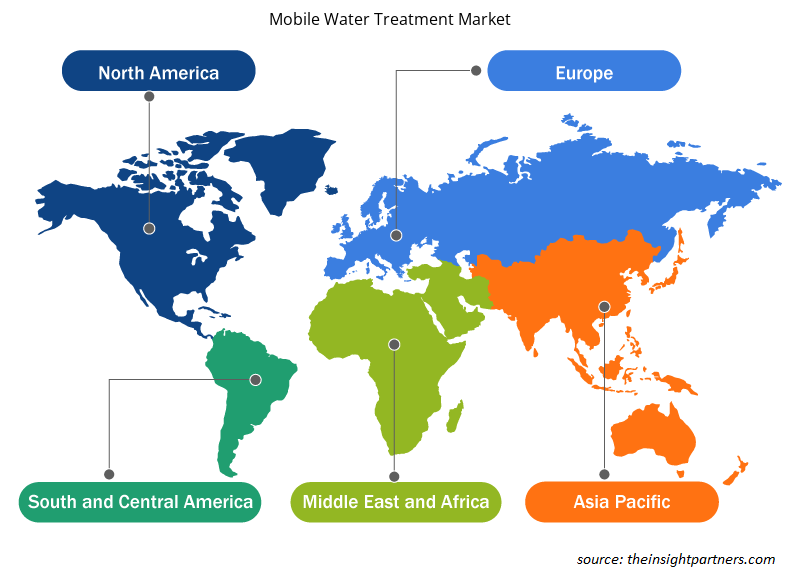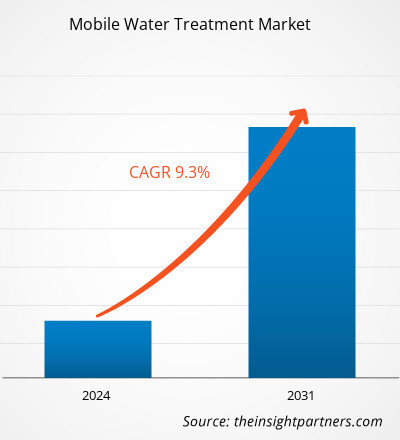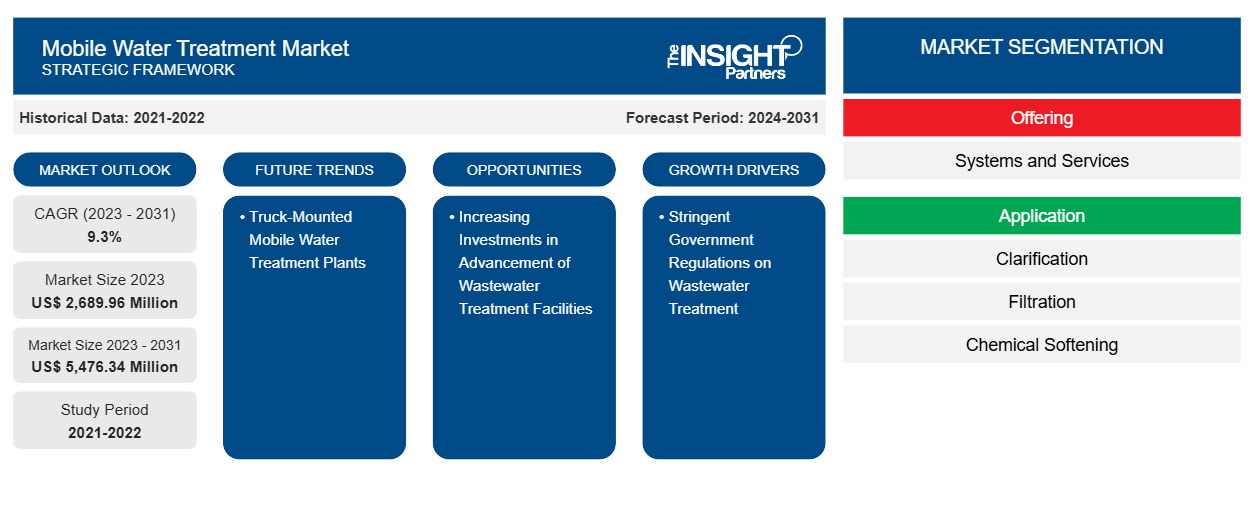Der Markt für mobile Wasseraufbereitung wird voraussichtlich von 2.689,96 Millionen US-Dollar im Jahr 2023 auf 5.476,34 Millionen US-Dollar im Jahr 2031 anwachsen. Der Markt wird voraussichtlich zwischen 2023 und 2031 eine durchschnittliche jährliche Wachstumsrate von 9,3 % verzeichnen. Die steigende Nachfrage nach sauberem und gereinigtem Wasser in zahlreichen Endverbraucherbranchen wie der Lebensmittel- und Getränkeindustrie, der verarbeitenden Industrie und der Pharmaindustrie sowie der zunehmende Fokus der Regierung auf die Eindämmung der Zahl wasserbedingter Krankheiten dürften weiterhin ein wichtiger Trend auf dem Markt bleiben.
Mobile Wasseraufbereitung Marktanalyse
Strenge staatliche Vorschriften hinsichtlich der angemessenen Nutzung von Abwasseraufbereitungssystemen vor Ort (OWTS) und die zunehmende Verbreitung von durch Wasser übertragenen Krankheiten werden zu den Hauptfaktoren, die das globale Marktwachstum vorantreiben. Ein hohes Maß an Bewusstsein für neue Technologien in entwickelten Regionen wie Nordamerika und Europa und ein steigender Bedarf an verbesserter Wasserqualität in kleineren Gemeinden im Rahmen kommunaler Projekte führten zu einer weltweiten Zunahme der Verbreitung mobiler Wasseraufbereitung.
Marktübersicht zur mobilen Wasseraufbereitung
Das gestiegene Bewusstsein für Gesetzesverstöße oder Grenzwertüberschreitungen führt in den Industrieregionen zu Strafen und günstigen Regelungen hinsichtlich der Wasseraufbereitung. Darüber hinaus verfügen die Industrieregionen über eine hochwertige mobile Wasseraufbereitung und haben weiterhin einen stetigen und hohen Bedarf an Wartungs- und Renovierungsarbeiten, was das Marktwachstum der mobilen Wasseraufbereitung weltweit ankurbeln dürfte. Darüber hinaus treiben die Zunahme staatlicher Vorschriften für die mobile Wasseraufbereitung, hohe Investitionen in Forschung und Entwicklung von Wasseraufbereitungstechnologie, eine wachsende Zahl von Innovationen und strategische Initiativen der jeweiligen Landesregierungen im asiatisch-pazifischen Raum das Marktwachstum in der Region voran.
Passen Sie diesen Bericht Ihren Anforderungen an
Sie erhalten kostenlos individuelle Anpassungen an jedem Bericht, einschließlich Teilen dieses Berichts oder einer Analyse auf Länderebene, eines Excel-Datenpakets sowie tolle Angebote und Rabatte für Start-ups und Universitäten.
- Holen Sie sich die wichtigsten Markttrends aus diesem Bericht.Dieses KOSTENLOSE Beispiel umfasst eine Datenanalyse von Markttrends bis hin zu Schätzungen und Prognosen.
Treiber und Chancen auf dem Markt für mobile Wasseraufbereitung
Strenge staatliche Vorschriften zur Abwasserbehandlung begünstigen den Markt
Das wachsende Bestreben der Regierung, durch Wasser übertragene Krankheiten zu reduzieren und die Verwendung von sauberem und gereinigtem Wasser in der Lebensmittel- und Getränkebranche, der Pharmaindustrie und in der Industrie zu fördern, dürfte den Markt für mobile Wasseraufbereitung weltweit ankurbeln. Regierungsinitiativen ziehen ausländische Direktinvestitionen an und fördern die Einführung fortschrittlicher Technologien. In Entwicklungsländern wie Indien haben Bevölkerungswachstum und Entwicklung im Industriesektor Druck hinsichtlich des Bedarfs an gereinigten Wasserquellen für die Nutzung in der Industrie erzeugt. Der nationale Mindeststandard wurde für zahlreiche Industriezweige in Indien eingeführt, um die Wasserverschmutzung zu begrenzen und den Zustand des Industriewassers zu schützen. Als Folge dieser strengen Kontrolle der Verwendung von sauberem Wasser wächst in Indien die Nachfrage nach mobilen Wassersystemen, was sich positiv auf das Wachstum des Marktes für mobile Wasseraufbereitung weltweit auswirkt.
Steigende Investitionen in die Weiterentwicklung von Abwasserbehandlungsanlagen
Die entwickelten Regionen freuen sich darauf, eine breite Palette von Wasseraufbereitungstechnologien einzuführen, vor allem für die mobile Wasseraufbereitung an abgelegenen Standorten wie Öl- und Gasstandorten und Baustellen. Außerdem ergreifen mehrere Unternehmen in der Region strategische Initiativen und investieren in fortschrittliche Technologien, was den Markt für mobile Wasseraufbereitung weiter ankurbelt. Das technologische Ökosystem in Nordamerika und Europa ist fortschrittlich. Die entwickelten Regionen konzentrieren sich auf Investitionen in fortschrittliche Technologien. So hat beispielsweise Veolia Water Technologies stark in mobile Wasseraufbereitungstechnologien investiert und große Probleme mit einem Wasserlösungsspezialisten gelöst und eine Reihe von Notfalldiensten für das Ausfallmanagement angeboten, was das Wachstum des Marktes für mobile Wasseraufbereitung in den kommenden Jahren vorantreiben dürfte.
Segmentierungsanalyse des Marktberichts zur mobilen Wasseraufbereitung
Wichtige Segmente, die zur Ableitung der Marktanalyse zur mobilen Wasseraufbereitung beigetragen haben, sind Angebot, Anwendung und Endbenutzer.
- Basierend auf dem Angebot ist der Markt für mobile Wasseraufbereitung in Systeme und Dienstleistungen unterteilt. Das Dienstleistungssegment hatte im Jahr 2023 einen größeren Marktanteil.
- Nach Anwendung ist der Markt in Klärung, Filtration, chemische Enthärtung, Umkehrosmose, Ionenaustausch und andere unterteilt. Das Filtrationssegment hielt im Jahr 2023 einen bedeutenden Marktanteil.
- Nach Endverbraucher ist der Markt in Bauwesen, Kommunalwesen, Landwirtschaft, Chemie und Sonstiges segmentiert. Das Segment Sonstige hielt im Jahr 2023 einen erheblichen Marktanteil.
Mobile Wasseraufbereitung Marktanteilsanalyse nach Geografie
Der geografische Umfang des Marktberichts zur mobilen Wasseraufbereitung ist hauptsächlich in fünf Regionen unterteilt: Nordamerika, Asien-Pazifik, Europa, Naher Osten und Afrika sowie Süd- und Mittelamerika.
Nordamerika ist Marktführer. Die Region freut sich darauf, eine breite Palette von Wasseraufbereitungstechnologien einzuführen, vor allem für die mobile Wasseraufbereitung an abgelegenen Standorten wie Öl- und Gasstandorten und Baustellen. Außerdem ergreifen mehrere Unternehmen in der Region strategische Initiativen und investieren in fortschrittliche Technologien, was den Markt für mobile Wasseraufbereitung weiter ankurbelt. Die USA sind Nordamerikas größtes Land und haben eine enorme Nachfrage nach mobiler Wasseraufbereitung. Der Fokus liegt zunehmend auf der Bekämpfung der Wasserverschmutzung, starken technisch-wirtschaftlichen Netzwerken und der wachsenden Zahl von Niederlassungen in Form neuer Produktionsanlagen, die das Marktwachstum in Nordamerika vorantreiben.
Regionale Einblicke in den Markt für mobile Wasseraufbereitung
Die regionalen Trends und Faktoren, die den Markt für mobile Wasseraufbereitung im Prognosezeitraum beeinflussen, wurden von den Analysten von Insight Partners ausführlich erläutert. In diesem Abschnitt werden auch die Marktsegmente und die Geografie der mobilen Wasseraufbereitung in Nordamerika, Europa, im asiatisch-pazifischen Raum, im Nahen Osten und Afrika sowie in Süd- und Mittelamerika erörtert.

- Erhalten Sie regionale Daten zum Markt für mobile Wasseraufbereitung
Umfang des Marktberichts zur mobilen Wasseraufbereitung
| Berichtsattribut | Details |
|---|---|
| Marktgröße im Jahr 2023 | 2.689,96 Millionen US-Dollar |
| Marktgröße bis 2031 | 5.476,34 Millionen US-Dollar |
| Globale CAGR (2023 - 2031) | 9,3 % |
| Historische Daten | 2021-2022 |
| Prognosezeitraum | 2024–2031 |
| Abgedeckte Segmente | Durch das Angebot
|
| Abgedeckte Regionen und Länder | Nordamerika
|
| Marktführer und wichtige Unternehmensprofile |
|
Marktteilnehmerdichte: Der Einfluss auf die Geschäftsdynamik
Der Markt für mobile Wasseraufbereitung wächst rasant, angetrieben durch die steigende Nachfrage der Endnutzer aufgrund von Faktoren wie sich entwickelnden Verbraucherpräferenzen, technologischen Fortschritten und einem größeren Bewusstsein für die Vorteile des Produkts. Mit steigender Nachfrage erweitern Unternehmen ihr Angebot, entwickeln Innovationen, um die Bedürfnisse der Verbraucher zu erfüllen, und nutzen neue Trends, was das Marktwachstum weiter ankurbelt.
Die Marktteilnehmerdichte bezieht sich auf die Verteilung von Firmen oder Unternehmen, die in einem bestimmten Markt oder einer bestimmten Branche tätig sind. Sie gibt an, wie viele Wettbewerber (Marktteilnehmer) in einem bestimmten Marktraum im Verhältnis zu seiner Größe oder seinem gesamten Marktwert präsent sind.
Die wichtigsten Unternehmen auf dem Markt für mobile Wasseraufbereitung sind:
- Veolia
- Aria Filter
- Evoqua Water Technologies LLC
- Ecologix Environmental Systems, LLC
- Aquatech International LLC
- Filtra Systems
Haftungsausschluss : Die oben aufgeführten Unternehmen sind nicht in einer bestimmten Reihenfolge aufgeführt.

- Überblick über die wichtigsten Akteure auf dem Markt für mobile Wasseraufbereitung
Neuigkeiten und aktuelle Entwicklungen zum Markt für mobile Wasseraufbereitung
Der Markt für mobile Wasseraufbereitung wird durch die Erhebung qualitativer und quantitativer Daten nach Primär- und Sekundärforschung bewertet, die wichtige Unternehmensveröffentlichungen, Verbandsdaten und Datenbanken umfasst. Nachfolgend sind einige der Entwicklungen auf dem Markt für mobile Wasseraufbereitung aufgeführt:
- Veolia Water Technologies hat seine Kapazitäten für mobile Wasserversorgungsdienste in Malaysia erweitert und drei neue mobile Anlagen in Betrieb genommen. (Quelle: Veolia Water Technologies, Pressemitteilung, März 2024)
- EDF hat sich in Partnerschaft mit REEL für die technologische Lösung von Veolia entschieden, um mobile Einheiten zur Behandlung von kontaminiertem Wasser im Falle eines Atomunfalls zu entwickeln, herzustellen und zu installieren. (Quelle: Veolia Water Technologies, Pressemitteilung, November 2023)
Marktbericht zur mobilen Wasseraufbereitung – Umfang und Ergebnisse
Der Bericht „Marktgröße und Prognose für mobile Wasseraufbereitung (2021–2031)“ bietet eine detaillierte Analyse des Marktes, die die folgenden Bereiche abdeckt:
- Marktgröße und Prognose für die mobile Wasseraufbereitung auf globaler, regionaler und Länderebene für alle wichtigen Marktsegmente, die im Rahmen des Berichts abgedeckt sind
- Markttrends und Marktdynamiken für die mobile Wasseraufbereitung, darunter Treiber, Einschränkungen und wichtige Chancen
- Detaillierte PEST- und SWOT-Analyse
- Analyse des Marktes für mobile Wasseraufbereitung mit Blick auf wichtige Markttrends, globale und regionale Rahmenbedingungen, wichtige Akteure, Vorschriften und aktuelle Marktentwicklungen
- Branchenlandschaft und Wettbewerbsanalyse, einschließlich Marktkonzentration, Heatmap-Analyse, prominenten Akteuren und aktuellen Entwicklungen auf dem Markt für mobile Wasseraufbereitung
- Detaillierte Firmenprofile
- Historische Analyse (2 Jahre), Basisjahr, Prognose (7 Jahre) mit CAGR
- PEST- und SWOT-Analyse
- Marktgröße Wert/Volumen – Global, Regional, Land
- Branchen- und Wettbewerbslandschaft
- Excel-Datensatz
Aktuelle Berichte
Verwandte Berichte
Erfahrungsberichte
Grund zum Kauf
- Fundierte Entscheidungsfindung
- Marktdynamik verstehen
- Wettbewerbsanalyse
- Kundeneinblicke
- Marktprognosen
- Risikominimierung
- Strategische Planung
- Investitionsbegründung
- Identifizierung neuer Märkte
- Verbesserung von Marketingstrategien
- Steigerung der Betriebseffizienz
- Anpassung an regulatorische Trends





















 Kostenlose Probe anfordern für - Markt für mobile Wasseraufbereitung
Kostenlose Probe anfordern für - Markt für mobile Wasseraufbereitung